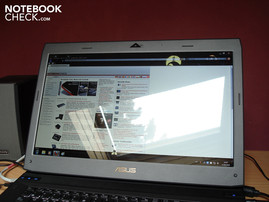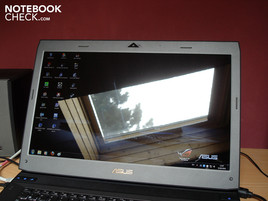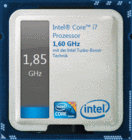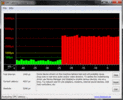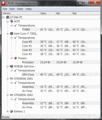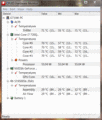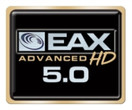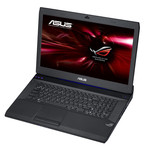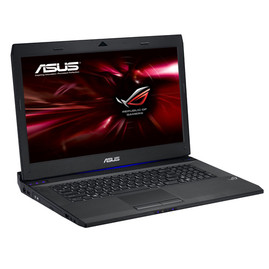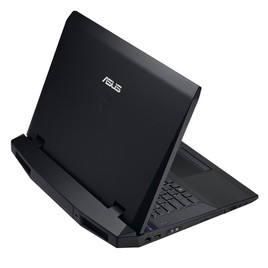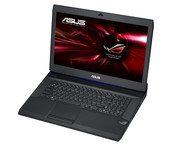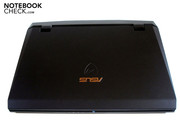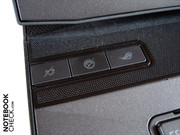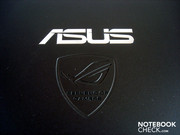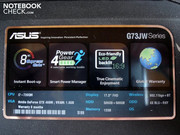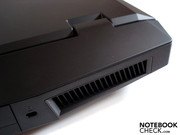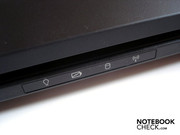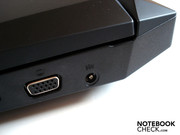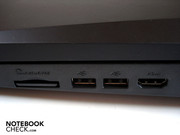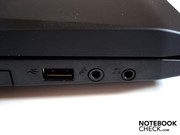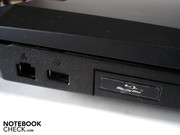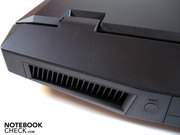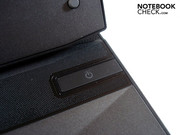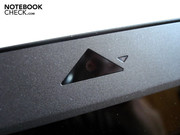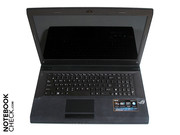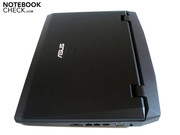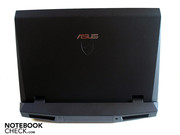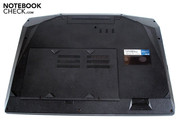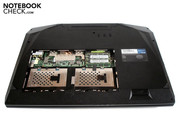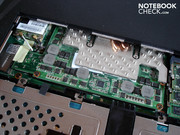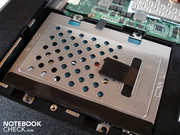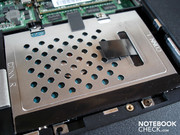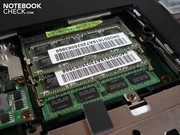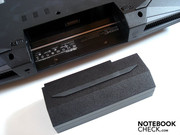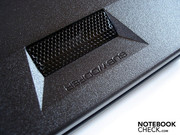Review Asus G73JW Notebook (GTX 460M)
Up till now Asus has been offering the G73 only with the Mobility Radeon HD 5870 from ATI, but soon the option of having the GeForce GTX 460M will mean more freedom for customers. Nvidia's new DirectX 11 firecracker competes with the Radeon HD 5870 not only on the level of performance, but its additional features (including PhysX and 3D Vision) definitely score it some points. So that we could get a real feel for the GeForce GTX 460M, Asus was kind enough to place at our disposal the not-quite-final "PR sample" of the G73JW, which in addition to the GeForce GTX 460M graphics card also came equipped with an Intel Core i7-720QM, 12 GB DDR3 RAM as well as two speedy hybrid hard disks each with 500 GB. Since we've already tested the G73 twice before and the exterior - except for a few details (USB 3.0 Port, HDMI 1.4) - has remained the same, we have left the sections "Case," "Input Devices," and "Connectivity" out of this review.
It's only fair that such a high-end notebook would have an HD screen. That's why Asus has fitted the G73JW with a 17-inch Full HD Display with a resolution of 1920 x 1080 and an aspect ratio of 16:9. This in combination with a built-in Blu-Ray drive means that film buffs will really get their money's worth. The relatively high resolution also has the benefit of reducing the amount of scrolling necessary with many open windows. Moreover, the GeForce GTX 460M is one of the few notebook graphics cards that can actually keep up with demanding resolutions like 1920 x 1080 while running games.
| |||||||||||||||||||||||||
Brightness Distribution: 85 %
Center on Battery: 178.5 cd/m²
Contrast: 939:1 (Black: 0.19 cd/m²)
Once again, the panel is luckily the Hannstar HSD173PUW1, which already generated a lot of buzz as the display for the full HD version of the G73JH with Radeon HD 5870. Thanks to the excellent black level of 0.19 cd/m², dark areas do not noticeably drift into the gray range, rather they are rendered as crips blacks. The contrast ratio of 939:1 is at a very high level as well, colors appear extremely vivid. Also, a brightness distribution of 85% leaves nothing to complain about. The brightness itself is the only thing that could be better. An average of 182.6 cd/m² is typical for office work and just right for internet use, but games and films would really be more enjoyable at a higher screen brightness.
Not only the heavy weight of four kilograms and the 17-inch screen but also the strong reflectivity of the display makes the G73 not too transportation-friendly, let alone good for outdoor use. At indirect viewing angles the very glossy screen surface often leads to distracting reflections even indoors.
The surprisingly good range of viewing angles, however, evens things out a bit. In the horizontal plane, colors and brightness only get distorted when looking at the screen from fairly large angles off to the side. Tilting the screen back and forth results in poor picture quality more quickly. Most notebooks are, nonetheless, worse off in this respect.
Performance
Before we get into the details about the hardware and its performance, an important mention: our "PR sample" from Asus is strictly a pre-production model. According to Asus, the models offered to the public will "definitely have less RAM (4 or 8 GB instead of 12) a higher CPU clock rate (740QM instead of 720QM)." Additionally, "software installation, bios and the exhaust fan controller" are not quite final and could be fundamentally changed.
Processor: Core i7-720QM
Our test model incorporates the Core i7-720QM processor with a quad core, which has also been used in other G73 models. Thanks to 774 million transistors and a 6 MB L3-cache, the processor possesses an extraordinarily high performance potential. The clock rate of 1.60 GHz is indeed quite low, but the Turbo Boost Technology can raise the speed to a maximum of 2.80 GHz. Asus has additionally fitted the G73 with its own overclocking feature "Twin Turbo," which raises the clock rate some more. Whether the performance actually improves in response to these features is a question that's answered in more detail in the "CPU Performance" section.
Furthermore, you have the option of including the Core i7-720QM with hyperthreading technology. This allows the simultion of four additional CPU cores, which is primarily advantageous in optimized applications. Gaming with hyperthreading is, however, still very limited. The greatest downside of the Core i7-720QM is the very high energy consumption of 45 watts.
Graphics Card: GeForce GTX 460M
So that Nvidia fans get their money's worth, Asus has decided to offer the G73 not only with the option of the Radeon HD 5870 but from now on with the (Fermi) GeForce GTX 460M. The specifications are really something impressive. For starters, the 1536 MB GDDR5 video memory with a 192 Bit connection sidesteps the problem of to-be-saved data getting bottlenecked and holding up processing, which is the case for the Radeon HD 5650. The clock rates, however, add up to only 675 MHz for the core, 1250 MHz for the memory and 1350 MHz for the shader. Additionally, the 192 unified shaders add to the guarantee of a satisfactory performance.
The list of features of the GeForce GTX 460M is also quite impressive, which supports Optimus (automatic switching between the integrated and dedicated graphics cards - not possible with the G73JW) as well as PhysX (GPU-based physics accelerator), not to mention the required DirectX 11. CUDA and DirectCompute, on the other hand, are designed to make general computations. Purevideo HD (decoding high-resolution content) and 3D Vision (rendering three-dimensional content - accessories required) are also mentioned as additional features.
CPU Performance
The Core i7-720QM scores some points with its outstanding performance thanks to its modern and efficient architecture. Its 3733 points in single-core rendering and 10,097 points in multi-core rendering correspond to just about the same level as other notebooks with the Core i7-720QM according to the Cinebench R10 tool. After activating the Twin Turbo Mode, the clock rate rises from 1.73 to 1.85 GHz under heavy use, which increases the performance measurably: the processor showed an 8% higher performance (totaling 4015 points) in single-core rendering and an increase of an entire 9% in multi-core rendering (totaling 11032 points).
| PCMark Vantage Result | 5804 points | |
Help | ||
GPU Performance
In order to more meaningfully rate the GeForce GTX 460M, we've chosen to compare it with the Asus G73JH (with Radeon HD 5870). The first surprise came in the 3DMark 05, in which the GeForce GTX 460M came in on top of the Radeon HD 5870 by 9% (19452 to 17928 points). The tables were turned in the 3DMark 06, when the GeForce GTX 460M was outdone by the Radeon HD 5870, by 2% mind you (12520 to 12802 points). The gap widened in the 3DMark Vantage, when the GeForce GTX 460M was beaten by a whole 9% (7366 to 8044 points). In the end, not too much could be gathered from the synthetic graphics benchmarks. So, what do the numbers show in actual gaming? More about that in a bit...
| 3DMark 03 Standard | 34673 points | |
| 3DMark 05 Standard | 19452 points | |
| 3DMark 06 Standard Score | 12520 points | |
| 3DMark Vantage P Result | 7366 points | |
Help | ||
Hard Drive
The G73JW comes with the option of having a so-called SSH drive. This is a combination of a conventional HDD (7200 RPM) with a 4 GB SSD, onto which frequently-used data is stored. Such hybrid hard disks should reach the performance level of an HDD with 10,000 RPM. Our test model came with two 500 GB SSH drives which together offer a great storage capacity of 1 TB. Thanks to the SSH, start and loading times of the operating system and programs seem shorter than with typical HDDs. Hybrid drives, of course, can't quite keep up with a single fast-paced SSD. The tool CrystalDiskMark recorded for the SSH drive a sequential read rate of 89.91 MB/sec and a sequential write rate of 93.01 MB/sec.
Latency
Improvements are still needed in the area of latency. Indeed, the typical response rate was just fine, under 500 µs. But as soon as we pressed the touchpad buttons, latency shot up to over 4000 µs. It appeared that not all the kinks have been worked out with the touchpad driver. Latency values this high in audio or video transmission can under some circumstances lead to skipping.
In contrast to the application benchmarks, there was a slight decrease detected in gaming performance as soon as the Twin Turbo Mode was activated. For this reason, we performed all the gaming tests without the built-in overclocking feature. Regardless, the GeForce GTX 460M was placed in direct competition not only with ATI's Radeon HD 5850 GDDR5 (MSI GX640) and Radeon HD 5870 (MSI GX740, Asus G73JH & Deviltech 9700 DTX), but also had to stand its ground against two models from Asus as well, particularly the old top-level model GeForce GTX 285M (MSI GT660 & mySN XMG8.c) and the new premium model GeForce GTX 480M (Clevo W881CU & Clevo D901F). All the benchmarks mentioned in the text below were produced under the resolution of 1920 x 1080.
Mafia 2
Whether Mafia 2 is a worthy sequel to the uncommonly successful and highly decorated first part of the gangster epic is currently debated. At any rate, the GeForce GTX 460M made out well in the integrated benchmark of Mafia 2. Even with very high graphics settings in place as well as 16x AF (anisotropic filtering), the average refresh rate of the screen stayed within the playable range (34 fps). GeForce GTX 285M and GeForce GTX 480M run the game a bit more smoothly at 37 fps and 41 fps respectively.
| Mafia 2 | |||
| Resolution | Settings | Value | |
| 1920x1080 | high, 0xAA, 16xAF | 33.9 fps | |
| 1360x768 | high, 0xAA, 16xAF | 51.2 fps | |
Dirt 2
This racing game comes with DirectX 11 support and works especially well with the graphics cards of the GeForce GTX 400 series. The G73JW is capable of running the game at a fluid 42 fps with high graphics settings and 4x AA (antialiasing). At this rate, the GeForce G73JW passes up its brothers with Radeon graphics cards, the Radeon HD 5850 GDDR5 and the Radeon HD 5870, which both run the game at 32 fps. However, the GeForce GTX 480M lands on top with 47 fps.
| Colin McRae: DIRT 2 | |||
| Resolution | Settings | Value | |
| 1920x1080 | Ultra Preset, 4xAA | 41.6 fps | |
| 1360x768 | High Preset, 2xAA | 73.8 fps | |
Crysis
The time-honored but still very resource-demanding Crysis pushes the GeForce GTX 460M to the limit. With very high graphics settings (no AF or AA), the game still runs at 13 fps, rendering it completely unplayable. The competition is also having a hard time bringing Crysis to the laptop screen with halfway fluid motion. With the GeForce GTX 285M (14 fps), Radeon HD 5850 GDDR5 (16 fps), GeForce GTX 480M (16 fps) and Radeon HD 5870 (17 fps), the first-person shooter appears equally slow. There's no way around this but to switch down the graphics settings to "high" or "moderate" (depending on resolution).
| Crysis - GPU Benchmark | |||
| Resolution | Settings | Value | |
| 1920x1080 | Very High, 0xAA, 0xAF | 13 fps | |
| 1024x768 | High | 50.7 fps | |
StarCraft 2
To be able to enjoyably play an RTS, 30 fps is usually enough. In the intro of the ambitious challenge "For the Swarm", we measured the frame rate of the GeForce GTX 460M at very high graphics settings to be 32 fps. Compare: GeForce GTX 285M and GeForce GTX 480M outdid our model at 33 fps and 37 fps respectively.
| StarCraft 2 | |||
| Resolution | Settings | Value | |
| 1920x1080 | ultra | 31.6 fps | |
| 1360x768 | high | 68.4 fps | |
Metro 2033
Next to Crysis and GTA IV, most notable is Metro 2033 for computation-intensive games. Thanks to this, the first person shooter looks very sharp with very high graphics settings, DirectX 11 mode, AAA (Analytical Antiailiasing) and 4x AF. But the meager 10 fps restricts even the thought of smooth game progression. The GeForce GTX 460M seems overwhelmed with these settings, and a refresh rate of 12 fps is nothing close to ideal.
| Metro 2033 | |||
| Resolution | Settings | Value | |
| 1920x1080 | Very High DX11, AAA, 4xAF | 9.6 fps | |
| 1600x900 | High DX10, AAA, 4xAF | 25.2 fps | |
Shift
Just like Colin McRae Dirt 2, Need for Speed Shift is also one of the games that due to its technical specifications tends to lean toward Nvidia graphics cards. With a refresh rate of 44 fps with high graphics settings, the GeForce GTX 460M surpasses not only the GeForce GTX 285M (39 fps) and the Radeon HD 5850 GDDR5 (40 fps), but even the Radeon HD 5870 (42 fps). Nevertheless, the GeForce GTX 480M is yet again in a league of its own at 52 fps.
| Need for Speed Shift | |||
| Resolution | Settings | Value | |
| 1920x1080 | all on/high, 4xAA, triliniarAF | 43.8 fps | |
| 1366x768 | all on/high, 4xAA, triliniarAF | 68 fps | |
Bad Company 2
If you want to lead the boys of Bad Company safely through the picturesque levels of the game in a full HD resolution, you'll have to either forego detail-enhancing settings or fall back on lower graphics settings. The refresh rate of 29 fps, a result of high graphics settings (HBOA on), 4x AA and 8x AF, can get on your nerves after a while. With a GeForce GTX 285M in your notebook, the frame rate drops a bit further (26 fps). Radeon HD 5850 GDDR5 (31 fps) and Radeon HD 5870 (32 fps) can hardly do any better. The exception, as always, is the GeForce GTX 480M, which manages the same demanding graphics settings at 38 fps.
| Battlefield: Bad Company 2 | |||
| Resolution | Settings | Value | |
| 1920x1080 | high, HBAO on, 4xAA, 8xAF | 29 fps | |
| 1366x768 | high, HBAO on, 1xAA, 4xAF | 54.2 fps | |
Risen
If you don't mind a shaky frame rate, then you can play the RPG Risen with high graphics settings and 4x AF enjoyably enough. At 28 fps, the GeForce GTX 460M ranks in a bit below the Radeon HD 5850 GDDR5 (29 fps), the GeForce GTX 285M (30 fps) as well as the Radeon HD 5870 (32 fps). Once more, the GeForce GTX 480M undisputedly takes first place with 36 fps.
| Risen | |||
| Resolution | Settings | Value | |
| 1920x1080 | high/all on, 0xAA, 4xAF | 28 fps | |
| 1366x768 | all on/high, 4xAF | 42.6 fps | |
Modern Warfare 2
Finally, we let the GeForce GTX 460M loose on the ever-popular Modern Warfare 2. The first-person shooter from Infinity Ward is, at 41 fps, luckily quite playable with very high graphics settings and 4x AA. The GeForce GTX 460, however, draws the shortest straw against the GeForce GTX 285M (43 fps) and the GeForce GTX 480M (49 fps). Since Modern Warfare 2 tends to run better on ATI graphics cards, Radeon HD 5850 GDDR5 (47 fps) and Radeon HD 5870 (50 fps) each rank well.
| CoD Modern Warfare 2 | |||
| Resolution | Settings | Value | |
| 1920x1080 | all on/max vsync off, textures extra, 4xAA | 41.3 fps | |
| 1366x768 | all on/high vsync off, high textures, 4xAA | 58.5 fps | |
Gaming Summary
All in all, the GeForce GTX 460M shows a very good performance. Other than with extremely demanding games like Crysis or Metro 2033, the DirectX 11-supporting high-end graphics card is powerful enough to run modern games in a high resolution with high graphics settings. Even antialiasing and anisotropic filtering can be activated without making most games unplayable. The Asus G73JW has no chance against powerful desktop PCs, but as far as notebooks go, it falls into the top echelon. Compared with the competition, the GeForce GTX 460M ranks in between the Radeon HD 5850 GDDR5 and the Radeon HD 5870 - a respectable feat.
All things considered, we compiled the following rankings:
1920 x 1080 | (very) high graphics settings:
1st Place: GeForce GTX 480M (+21%)
2nd Place: Radeon HD 5870 (+4%)
3rd Place: GeForce GTX 460M
4th Place: Radeon HD 5850 GDDR5 (-1%)
5th Place: GeForce GTX 285M (-6%)
| low | med. | high | ultra | |
|---|---|---|---|---|
| Crysis - GPU Benchmark (2007) | 50.7 | 13 | ||
| Crysis - CPU Benchmark (2007) | 47.4 | 12.2 | ||
| Colin McRae: DIRT 2 (2009) | 73.8 | 41.6 | ||
| Need for Speed Shift (2009) | 68 | 43.8 | ||
| Risen (2009) | 42.6 | 28 | ||
| CoD Modern Warfare 2 (2009) | 58.5 | 41.3 | ||
| Battlefield: Bad Company 2 (2010) | 54.2 | 29 | ||
| Metro 2033 (2010) | 25.2 | 9.6 | ||
| StarCraft 2 (2010) | 68.4 | 31.6 | ||
| Mafia 2 (2010) | 51.2 | 33.9 |
Emissions
System Noise
As mentioned earlier, the exhaust fan controller might undergo some changes for the finished product. According to our test model, the G73JW measures up very close to the G73 version with the Core i7-720QM und Radeon HD 5870 (see review). Under normal use (office, internet, etc.) both fans seem fairly quiet, occasionally making an audible swooshing noise. Under heavy use (games, 3D applications, etc.), the background noise increases to a clearly audible level. Nevertheless, the G73JW runs a good deal more quietly that many comparable gaming notebooks (for example MSI GX740). This impression is likely attributable to the pleasant sound of the fan, which always seemed constant and never distracting.
Noise level
| Idle |
| 33.5 / 33.5 / 34.3 dB(A) |
| HDD |
| 34.1 dB(A) |
| DVD |
| 37 / dB(A) |
| Load |
| 41.5 / 44.8 dB(A) |
 | ||
30 dB silent 40 dB(A) audible 50 dB(A) loud |
||
min: | ||
Temperature
The highlight of the G73JW is without a doubt the stunningly low case temperature. What particularly impressed us was the notebook's cooling ability under normal use, where neither the top nor the bottom half of the case exceeded a temperature of 31ºC. Under heavy use, parts of the case reached a temperature as high as 40ºC, but the palm rest remained well below at a comfortably cool 26ºC (max.). On the whole, the G73JW stays about 2-4ºC cooler than the G73JH with Core i7-720QM and Radeon HD 5870. A big improvement for this model is the palm rest temperature, which was recorded to be 10ºC higher in the G73JH-TZ014V review.
Now you'd guess that at least the hardware itself has to exhibit higher temperatures. But far from it! Even pushing the hardware to the limit for hours using the tools Furmark and Prime only raises the processor and graphics card temperature to 72ºC - an exceptionally good value. Under normal use, the hardware also stays appropriately cool at around 40ºC for the CPU and GPU.
(±) The maximum temperature on the upper side is 40.3 °C / 105 F, compared to the average of 40.4 °C / 105 F, ranging from 21.2 to 68.8 °C for the class Gaming.
(+) The bottom heats up to a maximum of 36.2 °C / 97 F, compared to the average of 43.3 °C / 110 F
(+) In idle usage, the average temperature for the upper side is 28.1 °C / 83 F, compared to the device average of 33.9 °C / 93 F.
(+) The palmrests and touchpad are cooler than skin temperature with a maximum of 25.7 °C / 78.3 F and are therefore cool to the touch.
(+) The average temperature of the palmrest area of similar devices was 28.8 °C / 83.8 F (+3.1 °C / 5.5 F).
User Temperature Tests
Thanks to Aleš Stojak we got some infrared shots of his G73JW-TZ083V (i7-740QM, GTX 460M, Seagate 750 GB und Corsair Force 3 SSD). The first 4 images show the laptop after 3 hours of full load (using Prime95 and FurMark). The second set of four images shows the device after 3 hours of idle (3% avg CPU load). The images come from a Fluke Ti9 (emission set to 0.95) at 22°C room temperature.
Speakers
If you don't want to have to hook your notebook up to external speakers to get decent sound quality, then the Asus G73JW is right for you. The integrated 2.1 combo, of course, can't quite match the precision, volume and authenticity of a balanced sound system, but the sound quality is, nonetheless, well above average for a notebook. Particularly the high maximum volume is not to be found with any of its competitors. Additional highlights include supported THX Surround Sound and EAX 5.0. EAX (Environmental Audio Extensions) is developed by the sound specialists at Creative and can - among other things - simultaneously produce the sound for up to 128 instrument parts. The list of games that support EAX is extensive, including many popular titles like Assassin's Creed, Bioshock and Mass Effect.
Battery Life
A key disadvantage of powerful hardware is its high energy consumption. Although Asus has fitted the G73JW with the relatively powerful 8-cell battery (75Wh), the battery life is rather short-lived under any and all conditions. Starting with the Classic Test of the Battery Eater tool, heavy use with the brightness turned all the way up and all energy saving features deactivated resulted in the battery getting exhausted after a mere 68 minutes. Watching movies with the power cord unplugged is hardly possible when the battery lasts about 1.5 hours (max. brightness, moderate energy saving settings). Surfing the internet with Wi-Fi (max. brightness, moderate energy saving settings) will get you little more than 2 hours away from a power source. Reducing the brightness to the lowest level and activating all energy saving settings increases the battery life only slightly, coming to exactly 2.5 hours according to the Readers Test of the Battery Eater tool.
In terms of energy consumption, our tests revealed several differences between the G73JW (GTX 460M) and the G73JH (HD 5870). While the GeForce GTX 460M consumes 28.4-38.6 watts under normal use, the model with Radeon HD 5870 has a far higher value of 38.2–54.4 watts. The tables turn under heavy use as G73JH utilizes 102.6–145.2 compared to 133.1-149.0 watts for the G73JW. Our guess: the GeForce GTX 460M is more efficient under light use than the Radeon HD 5870, but on the other hand burns up more energy under heavy use.
| Off / Standby | |
| Idle | |
| Load |
|
Key:
min: | |
Verdict
Besides the USB 3.0 port, the GeForce GTX 460M and optional hybrid hard drive, everything has stayed the way it was in the previous model. Far-reaching changes are, however, not necessary considering that the G73 is a fundamentally excellent gaming notebook. Thanks to its outstanding performance, the sharp display, comfortable keyboard and touchpad as well as above-average sound quality and relatively low temperature and noise output, the G73 can qualify as a full-fledged desktop replacement. Due to its heavy weight and generous dimensions, the 17-inch notebook is not really very transport-friendly. Nevertheless, thanks to its unique design and extraordinarily sharp display, jealous glances in your direction come guaranteed.
Like the phrase says, "nobody's perfect." So, upon close inspection it's easy to find fault with one aspect or another. Most notable in this light would be the lacking variety of ports. The fact that Asus held out on an ExpressCard reader as well as a Firewire and eSATA port is baffling at such a high price. At the same time, when you closely consider the situation, the last two above-mentioned ports will most likely be replaced by the USB 3.0 sooner or later.
By and large, the Asus G73 has truly earned a very good rating of 88%. For those looking for a powerful gaming notebook with excellent features which can also serve as a desktop replacement, the G73 would be a near-perfect companion.
Now, whether to choose a model with Radeon HD 5870 or with GeForce GTX 460M, is a question of personal preferences. Those looking for relatively unrestricted (gaming) performance are better off with the G73JH (HD 5870). For users that, however, want supported features like PhysX, the G73JW (GTX 460M) might be a better match.






